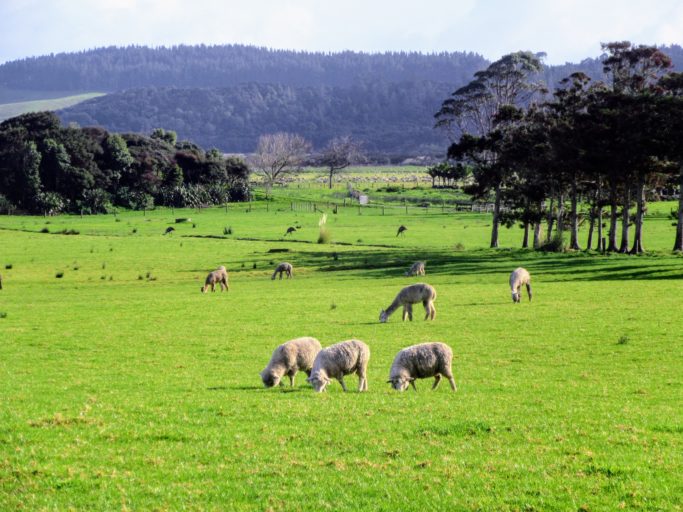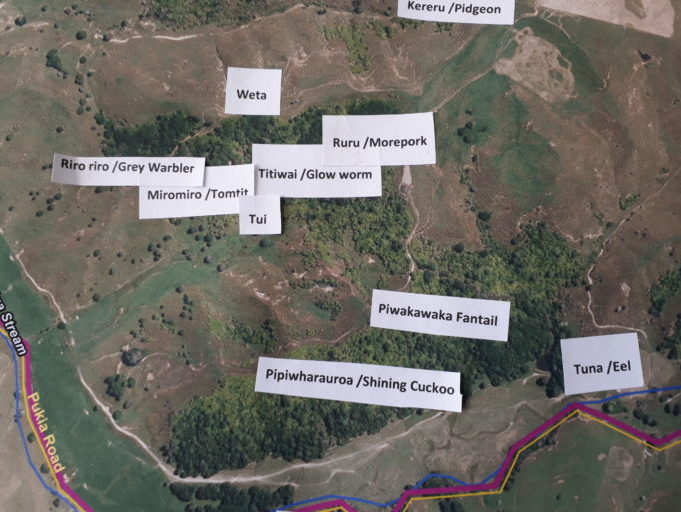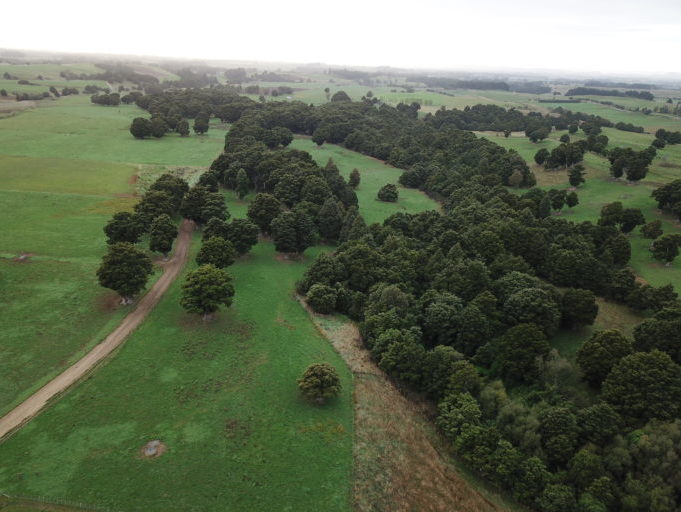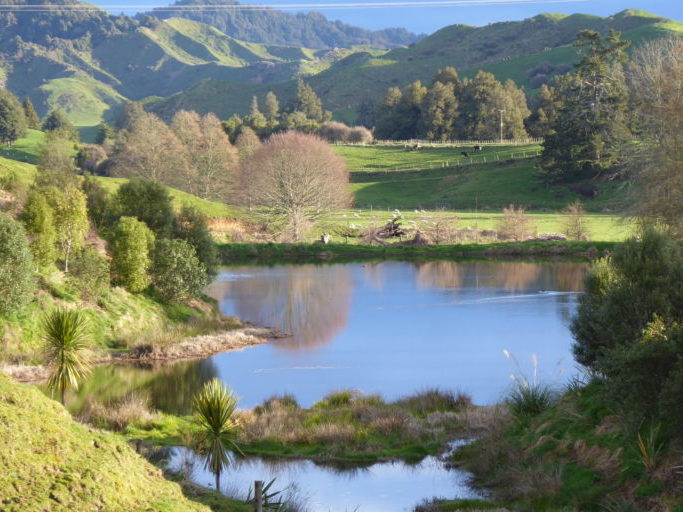What are New Zealand beef and sheep farmers’ views on managing and protecting native biodiversity on-farm and what barriers do they face to taking positive action? Those were some of the issues investigated in a nation-wide phone survey. Fleur Maseyk and colleagues report on their findings in the latest issue of the New Zealand Journal of Ecology.
Farmland matters to conservation as well as our economy. Nearly forty percent (39.7%, or approximately 10.6 million hectares) of New Zealand’s total land area is used for sheep and beef farming. That land supports one-quarter (24.5%, 2.8 million hectares) of the total remaining woody native vegetation. Sheep and beef farming thus supports the greatest proportion of remaining woody native vegetation outside of public conservation land.

“The way in which private land generally and sheep and beef land use specifically, is managed has major implications for biodiversity conservation nationally, and farmers, as land managers, have a critical role to play,” write the authors. “Biological invasions pose a sustained and growing threat to remaining biodiversity across all land tenures. Managing and protecting biodiversity on-farm provides vast opportunities to create nature-rich pastoral landscapes. A key step towards bringing about necessary behaviour change to achieve this is increasing insights into farmers’ attitudes towards the value of native biodiversity on their farms.”

By there very nature, however, many farm management practices have a detrimental effect on ecosystems – vegetation clearance, wetland drainage, grazing of forest remnants, application of fertiliser, herbicide and pesticides are some examples. But pastoral land also has a vast potential to create nature-rich landscapes, the authors believe.
“However, at the national scale, regulatory policy methods for the explicit purposes of biodiversity management are not uniform, and where they do occur, are often not coupled with the compliance monitoring and enforcement necessary to achieve policy objectives and are thus in effect, currently relatively scant. Further, additional policy responses and nudges such as economic mechanisms to incentivise specific behaviours are currently infrequently used, and not at all in many jurisdictions. Therefore, we are heavily reliant on farmers exhibiting probiodiversity practices on-farm on a largely voluntary basis; for example, actively planting, removing grazing to allow for passive regeneration, or placing areas under legal protection.”
Many farmers are – voluntarily – doing just that.
“By 2018 about 100,000 hectares (3% of remaining indigenous vegetation cover occurring on sheep and beef farms) had been legally protected under a Queen Elizabeth II National Trust Open Space Covenant.”
Yet despite both government and voluntary conservation activities across New Zealand, biodiversity continues to decline, including that on private land. So what more might be done on privately-owned farmland – and what are the barriers to making it happen?
The researchers used a questionnaire underpinned by the Theory of Planned Behaviour, to survey 500 sheep and beef farmers from around New Zealand as to their beliefs and attitudes and perceived barriers relating to the protection and management of native biodiversity on their farm.
“Our study was interested in New Zealand sheep and beef farmers’ perceived consequences from managing and protecting native biodiversity (expressed as advantages and disadvantages), and behavioural controls on doing so. These elements are theorised to influence behavioural intentions as conceptualised by the Theory of Planned Behaviour (TPB). The assumption of behavioural control is a critical factor of particular relevance to our study, in that negative perceived control factors (barriers; e.g. cost and effort) may prevent action even when the intention exists, while positive perceived control factors (facilitators; e.g. policy or financial incentives) may nudge behavioural intention towards behavioural action.”
A survey of 500 sheep and beef farmers was conducted by phone between March and April 2019. It comprised a total of 12 questions with additional questions relating to the characteristics of the farm and demographics of the respondents.

“Including preamble and postscript, the survey took approximately 15 minutes to complete. In this paper, we focus on data from four of the 12 questions. These four questions were open-ended to allow for unrestricted responses.”
The survey was carried out with the assistance of Beef+Lamb New Zealand.
“Beef+Lamb New Zealand is a farmer-owned organisation, funded by commodity levies on all sheep and cattle processed in New Zealand. The survey sample was stratified across the seven Beef+Lamb operational regions and 630 people initially agreed to participate. The 500 farmers screened into the survey included only those who self-identified that they had native biodiversity on their farm.”
Most respondants were older males of New Zealand European or Pākehā ethnicity – a homogenous group that yet had a range of different views. The authors describe the specific breakdown of survey respondants.
“The vast majority of survey respondents were male (90%; number = 449), most of whom were 45 or older (88%; number = 397). This age distribution was similar for the small group of female survey respondents, with 90% (n = 46) falling into the 45 or older age ranges. There was little ethnic diversity, with 95% (n = 474) of survey respondents identifying as New Zealand European or Pākehā; 3% (n = 15) as Māori; and 2% (n = 11) as other. Across all survey respondents, secondary schooling was the highest level of education for nearly half (49%; n = 243), followed by tertiary education (43%; n = 217). Threequarters of the survey respondents identified as owner/operators (76%; n = 379), with the remainder comprising owners, managers, and lease holders; and four (0.8%) respondents identified as directors or trustees.”
Encouragingly, almost all farmer respondents saw benefits in biodiversity.
“A total of 690 responses described advantages of managing and protecting native biodiversity on-farm (across the social, environmental, farm management, and economic themes), with only 8% (n=39) of farmers stating there were no advantages at all. Social advantages were the most prominent (47%; n = 327) and included benefits to the farmer, their family and staff, as well as off-farm advantages such as intergenerational equity and meeting the responsibility of land management. Environmental advantages were also common (34%; n = 238) and included concepts of benefits for biodiversity in and of itself, and contribution to other environmental considerations.”
Practical and economic benefits were mentioned much less often.
“Practical advantages, such as pro-diversity actions making farm management easier, were identified much less frequently (10%; number = 70). Economic advantages were infrequently mentioned (2%; n = 14), but responses were dominated by ideas relating to increased farm value due to biodiversity on-farm.”
The advantages outnumbered the disadvantages, as perceived by most sheep and beef farmers.
“In contrast to stated advantages, there were fewer, and less diverse responses relating to disadvantages (number = 530). No environmental considerations were identified as disadvantages. Nearly three times as many farmers stated there were no disadvantages at all (22%; n = 114) than stated there were no advantages. Economic considerations were most often mentioned (44%; n = 235); practical (26%; n = 140) and social considerations (25%; n = 130) were identified as disadvantages in almost equal proportion covering a greater range of ideas compared with economic considerations.”
Cost was a big issue.
“In terms of economic considerations, the cost of protecting biodiversity was by far the primary concern (40%, n = 211). In addition, 16 farmers (2%) were also concerned with the lack of financial return, expressed by one farmer as “paying rates for land we do not even get an income from”. Protecting biodiversity was seen as a distraction from the core business of farming by a few (1%, n = 8), with one farmer noting ‘it would interrupt our farm business’.”
Time was another key issue.

“Social disadvantages were heavily weighted towards the investment of time (13%, n = 68), and this social investment was closely related to the cited financial cost of managing and protecting biodiversity on-farm. A related social disadvantage was the fact it “creates a lot of extra work”, although comments describing labour needs were less common (5%; n = 27). Eighteen (3%) of the comments describing disadvantages related to policy and regulation, as characterised by this comment from one farmer ‘the controls that are put onto to us from the council that limits us’, and another suggesting such requirements are ‘infringing on property rights’. One farmer felt such controls were uninformed and they were ‘getting told what to do from people who don’t even know what they are talking about’.”
Encouragingly, nearly one-third of farmers surveyed (31%; n = 157) felt that there were no barriers to managing and protecting native biodiversity on-farm.
“From the remaining farmers, the survey yielded 481 responses relating to barriers, spanning economic (44%; n = 214), social (37%; n = 176), environmental (9%, n = 44), and practical (7%; n = 36) considerations. Of the economic barriers identified, the vast majority (95%; n=204) were categorised as financial implications (e.g. “cost”). A lack of resources was also identified as a barrier, but only by a few farmers (2%, n = 10).”
Social considerations were more wide-ranging.
“Half (50%; n = 88) of the identified social barriers related to the time required to manage and protect biodiversity on-farm. Policy and regulatory requirements were viewed as a barrier by some farmers (7%; n = 36). Frustration was expressed that, as one farmer put it ‘rules and red tape get in the way from managing it myself’. The lack of labour was also perceived to be a barrier by some (7%; n = 34), which, while categorised here as a social consideration, also has financial implications.”
Bad press for farmers was also resented and considered a barrier.
“A few farmers (2%; n = 11) felt that attitudes of the wider community created barriers (e.g. ‘stigma of being a farmer’, ‘people’s romantic ideas about biodiversity’) and there was frustration expressed towards ‘do-gooders’ and ‘townies’ amongst these responses. Few farmers (1%; n = 7) saw their lack of knowledge as a barrier, whether that was ‘a lack of knowledge of pests’, or in terms of ‘understanding how much that is impacting’.”
So what can we do to make it easier for farmers to manage and protect biodiversity on-farm?
“Fifty-two farmers (10%) were not sure what actions would make the job of managing and protecting biodiversity easier for them and 77 farmers (15%) said ‘nothing’ would. A total of 457 ideas of how to overcome barriers were expressed. Economic (44%; n = 200) and social considerations (44%; n = 199) were most frequently mentioned. Practical considerations were much less frequently mentioned, accounting for only 8% (n = 36) of responses.”
A total of 191 respondants (42%) mentioned increased resourcing as a key mechanism to make the managing and protecting of biodiversity on-farm easier.
“This resourcing included direct covering of costs to undertake actions, such as funding, subsidies, or grants or covering the costs in full whether by ‘somebody paying me to do it’ or ‘if the government would pay for it’. In addition to increasing financial resourcing, the need for additional practical assistance was frequently mentioned (14%; number=63). This most often applied to fencing or planting but also a general desire for ‘more help with things’ was mentioned. In a similar vein, overcoming labour issues was a relatively common response (4%; n = 20).”
So is it time for conservation-minded ‘townies’ to offer to help out on the farm?

“Assistance with weed and pest control (e.g. ‘if we could get assistance to control the pests’, ‘access to traps’) was also raised (8%; n=38), and this included others (typically councils) doing a better job. As one farmer suggested, ‘somebody could control the rabbits’.”
Twenty respondents (4%) mentioned overcoming a negative community attitude towards farmers and the farming industry, reflecting an element of frustration with the non-farming community.
“This was expressed as, for example, ‘a reduction in the negative attitude of greenies, Fish and Game etc.’, or a wish that effort put into criticism of farming could instead be directed into positive actions. For example, ‘all the moaning townies can come out on a Saturday and help me plant trees’. Some farmers also expressed a desire to be better appreciated, as one farmer put it, ‘[I] would like recognition from urban people’.”
Overall, the study suggests that further effort is required to ensure farmers feel more supported, and therefore more able, to undertake biodiversity management on their farm.
“The need for advice and support to accompany initiatives (e.g. agri-environmental schemes) to encourage pro-biodiversity behaviour is common. However, any provider of advice will need to understand farm systems as well as ecological restoration to overcome concerns of uninformed interference that was expressed by a small minority of farmers in our study.”
The study also shows that the financial and time investment required is a major barrier to undertaking pro-biodiversity actions on farm. This suggests that farmers are weighing financial considerations against environmental and conservation considerations, the authors believe. But its an investment worth making – particularly when you weigh up the much higher costs of fixing environmental degradation after it has occurred.
“Incentivising the maintenance and enhancement of existing biodiversity values is especially relevant given the costs of addressing environmental degradation and depletion of natural capital is escalating for both the private and public purse. Examples of this increased expenditure include the $8.8 million Hill Country Erosion fund (Ministry for Primary Industries 2019), and the $100 million invested in the Freshwater Improvement Fund (Ministry for the Environment 2019).”
“Increasing the understanding of the value of biodiversity to the farm system and maintaining profitability will help shift perceptions towards biodiversity from a ‘nice to have’ to an investment that makes good business sense. Resourcing invested by councils and industry groups to build on this momentum will make a valuable contribution to improving biodiversity stewardship on-farm.”
The full article is published in the New Zealand Journal of Ecology and is freely available online.
Managing and protecting native biodiversity on-farm – what do sheep and beef farmers think? (2020)

